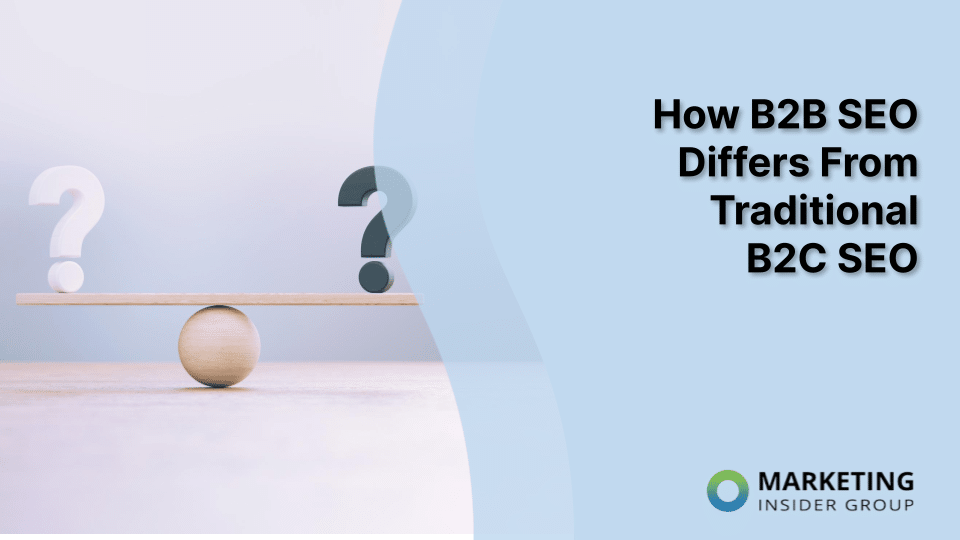
What Is an SEO Marketing Strategy?
Your SEO marketing strategy is the key to unlocking your brand’s growth potential. It’s how you rank on search engine results pages (SERPs), drive organic traffic to your website, and ultimately grow conversions and sales.
Even though every marketer today has heard of SEO and most know its importance, most brands approach SEO with a variety of separate tactics rather than linking it to your overall marketing strategy. The result is a fragmented SEO effort that doesn’t earn nearly the ROI it could.
In this article, we’re going to cover what constitutes a true SEO marketing strategy, how content marketing supports it, the most important components, and ways you can begin building yours right away.
Quick Takeaways
- A cohesive SEO marketing strategy optimizes individual tactics like keyword targeting and backlinks.
- There are no shortcuts to a great strategy. The best way to rank is to consistently create high-quality, human-focused content.
- Technical SEO plays a critical role in enabling search engines to find and index your content.
- Knowing your competitors and what exists already on SERPs can help you capitalize on SEO opportunities with your content.
- Your SEO marketing strategy should be metrics-driven, using specific KPIs to evaluate how well your strategy is working.
PS – I put together these 10 tips for optimizing your content marketing. Watch Now!
What is an SEO marketing strategy and why is it important?
An SEO marketing strategy is a brand’s overarching approach to improving search engine rankings to drive more organic traffic. When most people think of SEO, they think of things like keywords and backlinks, and these things are components of a good SEO strategy. But they aren’t going to be as effective as they could be unless there is a detailed plan behind the way they are implemented.
A true SEO marketing strategy goes beyond individual tactics to think holistically about the way your brand is represented online. It puts you in control of what kinds of searches your brand is represented in, which content is shown to users at different stages of the customer journey, and how your value proposition and overall brand stacks up to your competition on SERPs.
Why is all of this important?
Consider these statistics:
- 93% of online experiences today begin on search engines. If you aren’t ranking for the right searches and appearing near the top of the list, you’re essentially invisible to potential customers.
- More than half of all web traffic is driven by organic search (compared to paid ads and social media, which drive 10% and 5% of traffic respectively).
- Less than 1% of Google searchers ever click on results from the second page
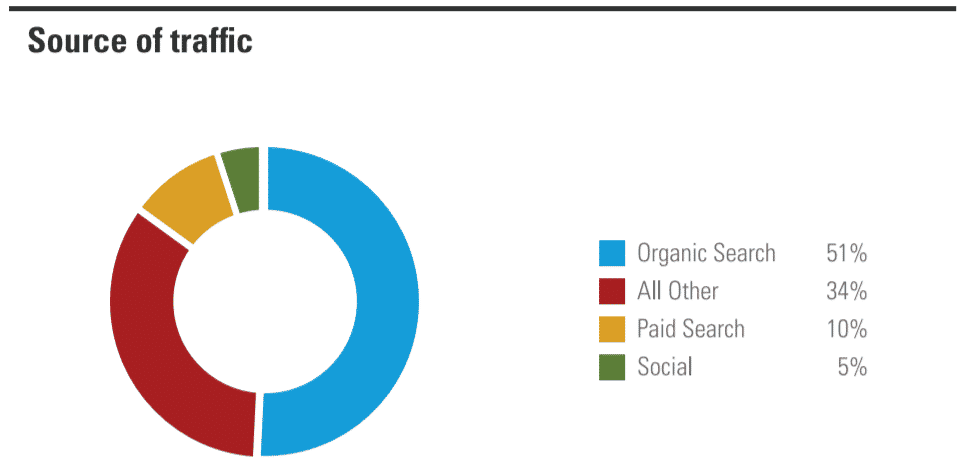
In short: if you aren’t ranking high on SERPs, you’re invisible to your potential customers.
PS – Check out our weekly blog content service to grow your website traffic and leads!
Components of a strong SEO marketing strategy
Topic clusters
Keywords are important, but your topic clusters are the foundation of your keyword strategy. When you decide on the high-level topics your brand should have authority and presence for, you can be more intentional about the keywords you target.
When you use topic clusters to build your SEO marketing strategy, you can cover a wide range of keywords that fall under one cluster, creating pillar content (more on that later) covering the main topic and linking out to more of your content that covers subtopics within that cluster.
This approach enables you to rank for both high-volume short keywords and long-term, niche keyword phrases that fall under it.
Keyword targeting
Keywords are words and phrases commonly searched for on Google. They’re one of the main determining factors in your SERP rankings because, when used correctly, they tell search engine crawlers what your content is about.
Keyword targeting requires more strategy than it did in the past. Google penalizes brands who simply stuff keywords into content with little meaning, and they use sophisticated AI tools to determine which content under a certain keyword is the most relevant and valuable for users.
The best way to ensure your keyword targeting is on the mark is to perform thorough keyword research. Tools like SEMRush and Ahref’s make this easier than ever. Check out this quick tutorial on SEMRush’s Keyword Magic Tool to see how it works:
Metadata
Metadata like your title and meta description are the first things a user sees when your brand appears in their search result.
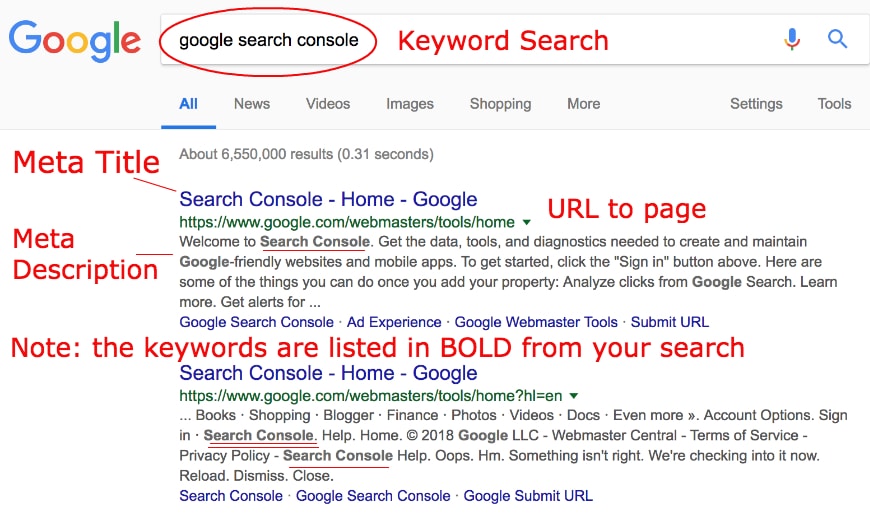
Similar to subject lines of emails, your metadata helps users decide if they want to click on your content. As such, metadata should never be approached as an afterthought. Use it to make a compelling case for your content. When done consistently over time, great metadata will boost your SEO marketing strategy by driving more engagement and traffic to your site.
Technical SEO
Technical SEO is the nuts-and-bolts part of your overall SEO marketing strategy. Defined briefly, it’s the process of keeping your website’s structure and content aligned with technical search engine requirements.
Strong technical SEO allows search engines to easily find, crawl, and index the pages on your site — a key part of earning SERP rankings. There’s a lot to know when it comes to technical SEO. (Let us know if we can help – we can include an SEO audit in any client engagement!)
Internal linking
Internal linking is an important component of on-page SEO, which is the process of optimizing individual web pages to earn the most relevant content possible. Mainly, you want to use high-authority, high-ranking pages to drive more traffic to other pages that need more of both.
Here’s a more in-depth look at internal linking from Ahref’s:
Backlinks
Backlinks occur when other (preferably high-authority) sites link back to your content, driving more organic traffic. There are a lot of methods you can find out there for intentionally building backlinks, but really, it’s just a long game. The best way to earn backlinks is to create consistently great content over a long period of time.
Here’s more on backlinks in one of our previous articles.
PS – Check out our latest case study that shows how we helped one company double their leads!
Ways to develop a strong SEO strategy
Write for humans first
Google ranking algorithms are smarter than ever. There are no shortcuts or easy ways to cheat the system and earn rankings faster. The best way to build a solid SEO marketing strategy and earn higher rankings is to focus on the real humans who make up your customer base and the kind of content that will add value for them. Google will recognize authentic, valuable content and rank it accordingly.
Create pillar content
Pillar content aligns with your topic clusters. These pieces serve as your anchors to the topics you most want to rank for. They are typically evergreen pieces and the main sources of internal links to other content.
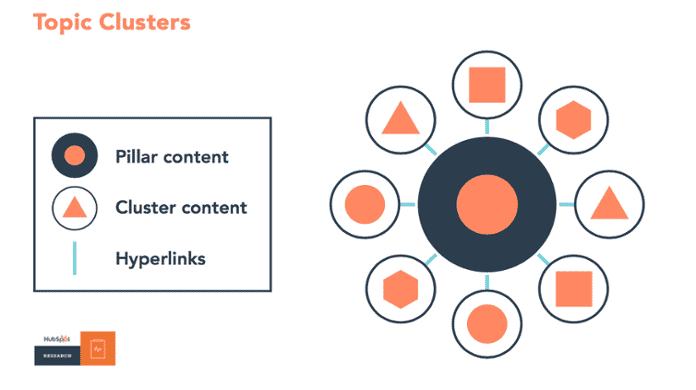
Know your competitors
To be as informed as possible as you build your SEO marketing strategy, you should get to know what the SERPs look like for your target keywords. What brands are already ranking? What kinds of content are at the top of the list?
You can use this information to conduct deeper competitive analyses and create skyscraper content that adds even more value for your customers than what already exists.
Pay attention to search intent
Aligning your content with user search intent increases the likelihood that they’ll engage and ultimately find value from it. Intent is an important part of making sure the right content gets to the right customer at the right time. Ask yourself: what are people looking for when they search for a specific keyword or phrase?
Look at the existing SERP to see what’s already ranking high. These processes will tell you, for example, whether to create an in-depth guide or quick punchy list for a target keyword. Even more importantly, can help you understand where your potential customer is in the buying process when they interact with your content.
Refresh old content
There are many reasons old content may drop in rankings or lose traffic over time. Google ranking factors change, content becomes outdated, competitors create new content, and Google prefers fresh content overall.
But none of these make your old content unusable — in fact, keeping your existing content updated is a smart way to boost new traffic and create compounding ROI on your content over time. It also ensures your SEO marketing strategy isn’t dragged down by content that’s no longer performing.
Here’s real data tracked by HubSpot on the performance of several blog posts pre- and post-update:
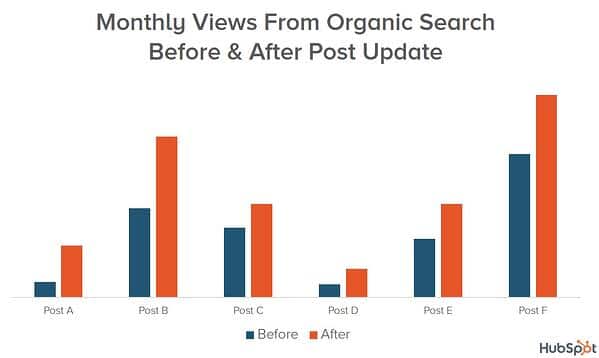
We look back at our own articles and regularly refresh content that used to rank or get lots of traffic. Competing articles are pruned and re-directed to the updated refresh.
Be metrics-driven
Last but not least, keep your SEO marketing strategy metrics-focused. When you measure your performance regularly, you’re able to know if your strategy is working and when you need to make adjustments. We recommend starting with these five key content marketing metrics:
- Traffic – Measure the number of unique visitors to your site, page views, and unique pageviews to understand how much traffic your site is attracting.
- Conversions – Conversion means something different for every brand. It could be a subscription, download, or purchase. Mainly, you’re measuring the rate at which users are taking the specific action you’re asking them to take.
- Engagement – This one is a little less cut-and-dry. A good tool to use is the Audience Overview dashboard on Google Analytics, which shows you metrics such as session length and average number of pages viewed per session.
- SEO performance – Measure your rankings across your target keywords and content.
- Authority – High authority not only increases rankings but builds brand trust and reputation.
Strategy + Quality + Consistency = Content Marketing Success
Marketing Insider Group’s Content Marketing Strategy and SEO Blog Writing services will help you develop an effective strategy, implement it to hit your goals, and track important KPIs.
We can create quality, optimized content for you to publish on your website every single week. We’ll also promote your content for higher visibility and track your ROI so you know exactly how it’s performing.
Ready to get started? Schedule your quick consultation today.

